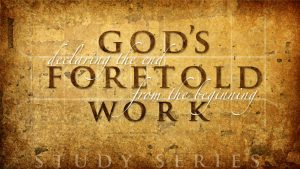I first discovered almost everything I’ve come to believe about Israel’s future destiny from a crisis over the question of why the Lord had not come, when it appeared that He Himself had expected to return before the expiration of His own contemporary generation (Matt 24:34, Mk 13:30). This pressed hard on me. I knew that Jesus could not be in error. That painful question was answered to my complete satisfaction when I happened to read 2Thes 2. There it became clear to me why the Lord had not already returned. Just as Jesus had come in the fullness of time to fulfill what Paul calls, “the mystery of godliness (1Tim 3:16), just so, another is coming (in his time) who will fulfill the mystery of iniquity (2Thes 2:7), which is somehow necessary before Jesus can return. Even then I suspected that the plan of God, and the comprehensive ‘mystery of God’ (Rev 10:7), is built around these two incarnations of the two seeds spoken of in Gen 3:15.
Later, I would learn the versatility of that term, generation, and come to conclude that Jesus was speaking of a continuum of a God opposing disposition that would persist until the end (Mt 23:30-39; Acts 7:51), requiring the final tribulation to fully and finally break its power (Deut 32:36; Dan 12:7). Of course, there are other ways of understanding Jesus’ meaning, such as the generation that sees the definite signs would not pass away before the full end. That curious usage has posed a difficulty for many, and has been greatly exploited by infidels, since it is obvious that Jesus didn’t return in His own generation. However, it is also clear that that generation did not escape the severity of judgment on Jerusalem, even if some things were left unfulfilled in order to point on towards a more exhaustive fulfillment in the future.
In any event, it was when I noticed that Jesus had instructed His disciples to read and understand Daniel that prophecy began to open up. I am glad I did not read Jesus’ words, “let the reader understand” (Mt 24:15), in the way that many translators have understood it to be nothing more than an editorial directive of Matthew. On the contrary, this is NOT Matthew’s insertion, it is Jesus Himself directing His disciples to read and understand Daniel’s references to this event in particular. Jesus well knew that when they would do that, they would see all that leads up to this event, and all that follows after, it would prove a tremendous key towards understanding the very thing about which they had specifically asked, i.e., “the sign of your coming and the end of the age”. Significantly, that word, “understand” appears with great frequency throughout the book of Daniel. In short, it was that almost unconscious obedience to the Lord’s simple directive that was the beginning of my understanding concerning Israel and the end times. That’s when I became what amillennialists and preterists call a “futurist” :-).
From there, I saw the same pattern everywhere in the OT. Everything lined up with a future day of the Lord that was invariably always centered on a last day’s controversy over what was manifestly a very literal Jerusalem, the ‘controversy of Zion’. The fact that the temple and city of Jerusalem lay in ruins and nearly bereft of Jewish population for so many centuries helps to explain why the church did not tend to interpret the prophecies literally; notwithstanding, there was always some who continued to look for a return of the Jews in unbelief in order for the prophecies to be fulfilled in a future desolation of a literal Jewish Jerusalem.
In my early study of eschatology, I was impressed at how often the prophets would present the events leading up to the day of the Lord in the context of a covenant. The whole prophetic picture was cast in a covenant contention that concerned, not only the people of the long exile, but the literal Land and city (Eze 39:22-29).
I could see that this well known part of Israel’s expectation and hope had served to actually eclipse and hide the bigger picture, despite its being all completely foretold (Acts 26:22; Ro 16:25-26) in the OT scriptures. I saw that the well known OT ‘day of the Lord’ formed the background and context for the mystery or secret of the gospel. The revelation of the mystery came directly out of the prophetic writings of the OT scriptures (Ro 16:26), but only since Christ’s first coming did it become possible to discern the hidden age that stands between the two comings. Two distinct comings could not be clearly distinguished before the appointed time of revelation (1Pet 1:11-12). I have come to the conviction that the far end of the same mystery that stumbled Israel, will once more test all who are in the nations, but first the church (1Pet 4:17). It is happening now.
Once I saw the relation of the tribulation to Christ’s return, and the relationship of the final beast to both the saints and to unbelieving Israel, it was not far to see that the tribulation was not only about the purification of the church, but the time of Jewish return from the age long exile of blindness to the gospel. They would not always be “enemies for our sake”. One surviving third would be born in a day (Isa 66:8; Eze 39:22; Zech 3:9; 12:10; 13:8-9). So what of this great day of the Lord that would come “immediately after the tribulation of those days”? (Compare Mt 24:29 with Acts 2:20). Were the many promises that the Hebrew prophets associated with ‘that day’ to be interpreted only spiritually? Were they to be applied only and finally to the present outpouring of the Spirit? Or were they still steadfast with God’s design to bring a deeply chastened nation back under the “bond of the covenant? (Eze 20:37). What had changed?
In one sense, the revelation of the mystery of the gospel did not change any part of the promises of the OT; it certainly didn’t cancel anything. Christ would one day appear to His estranged Jewish brethren at the end of the great tribulation (Jer 30:7; Dan 12:1; Mic 5:3; Zech 12:10; Mt 23:39; Rev 1:7). But in another sense, everything had changed. A blessed vista of unspeakable glory broke upon the understanding of the early church, far beyond anything conceived or thought possible. No wonder Paul says, “eye has not seen nor has the ear ever heard …”
The gospel reveals a glory that far surpasses anything expected by even the most saintly OT believer, things so glorious that the angels can only desire to look into (1Pet 1:12). Peter shows how that it is by these “exceeding great and precious promises that we are made partakers of the divine nature” (2Pet 1:4). It is the transforming vision (Ro 11:33-36; 2Cor 3:18). It is not enough that we get the facts. We must get the glory.
[Reggie Kelly – July 2011]




